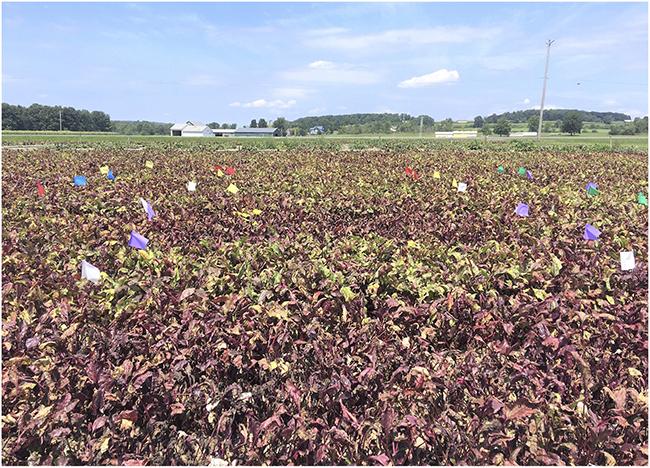
Credit: Sarah J. Pethybridge, Sandeep Sharma, Zachariah Hansen, Julie R. Kikkert, Daniel L. Olmstead, and Linda E. Hanson
A plant pathologist at Cornell University, Sarah J. Pethybridge supplies New York vegetable growers with the information they need to control soilborne diseases and adopt effective management strategies. She crafts her research around conversations with table beet growers about productivity issues in the field. These growers continuously expressed frustration with maintaining healthy foliage.
Cercospora leaf spot (CLS), which appears as small gray to black-colored lesions on leaves, is the dominant disease affecting table beet foliage in New York. CLS epidemics occur annually and can lead to defoliation and significant crop loss as healthy leaves are important to facilitate harvest by top-pulling.
Growers control CLS using fungicides. Through current management practices, growers begin spraying fungicides once they see one lesion per leaf then continue applying fungicides on a calendar basis.
Pethybridge and her team conducted a study to examine the efficacy of this treatment using three different fungicides and assessed the potential of using a risk-based model to improve fungicide timings. They found that two of the fungicides significantly improved CLS control if treatment was applied before the pathogen was present while the third fungicide worked best based on the current treatment model. Moreover, application of the first two fungicides were reduced from three to two using a weather-based risk model.
“This shows there is an opportunity to reduce spray frequency by scheduling on weather-based risk rather than calendar applications,” Pethybridge explained. “But different fungicides vary in the optimal risk threshold. The action thresholds and risk thresholds need to be assessed for each fungicide to be used for optimal disease management, but there are opportunities for improving disease control and reducing fungicide use with these tactics.”
Use of a weather-based decision support system to schedule fungicides for the control of CLS in table beet reduces unnecessary expense to the grower and unnecessary exposure of a fungal population to single-site modes of action posing a high risk of resistance development. For more information, read “Optimizing Cercospora Leaf Spot Control in Table Beet Using Action Thresholds and Disease Forecasting” in Plant Disease.
###
Media Contact
Ashley Bergman Carlin
[email protected]
Related Journal Article
http://dx.




